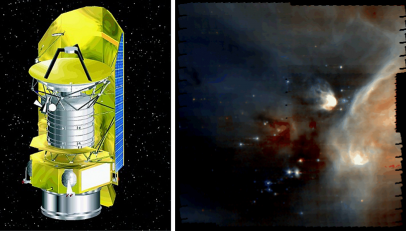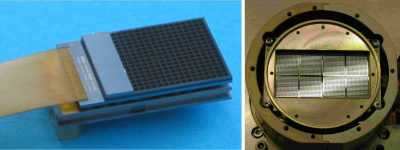 |
Herschel |
 |
|---|
An Infrared and Sub-millimetre Observatory
The Herschel telescope is a scientific space mission developed by the European Space Agency (ESA) dedicated to observing the Universe in the infrared and sub-millimetre ranges (wavelengths between 60 et 670 µm), a window of the electromagnetic spectrum that is still largely unexplored. It measures 9 m in length, 4 m in diameter and will weigh over 3 metric tons upon launch. Herschel arrived at ESA in January 2008 and will be launched by an Ariane 5 rocket from Kourou on 31th, October 2008. It will then be, with its 3.5 m-diameter mirror, the largest telescope ever sent into space.
The main objectives of the mission are based on two approaches related to the question of Origins. Close to Earth, Herschel will probe the molecular clouds, which are true breeding grounds for young stars, with a view to understand the first stages in star formation. Further away, it will map out the heavens to discern galaxies at the time they were formed and thus enrich our attempts to explain the evolution of the Universe, from the Big Bang to the present.
To achieve these objectives, the Herschel telescope’s focal plane houses three instruments that work in complement with one another: HIFI, a very high-resolution spectrometer and two cameras, SPIRE and PACS. Observation of this range of wavelengths requires instruments to be cooled to extreme temperatures, close to absolute zero. The PACS camera has two detector arrays, red and blue, and consists of matrices of bolometers cooled to a temperature of 300 millikelvins. The development of this camera is a major achievement of modern technology.
The Herschel mission has been developed through a mostly European collaboration, with significant US contribution. CEA is deeply involved in the development of instrumentation for Herschel. The LETI (Laboratory of Electronics and Information Technology in Grenoble) is developing and manufacturing the detectors for the PACS camera while the SBT (Low Temperature Department in Grenoble) is equipping SPIRE and PACS instruments with cryo-refrigerators designed to cool the detectors to a temperature of 300 millikelvins. DAPNIA is responsible for the construction of the PACS camera and its associated electronics, together with much of the electronics for the SPIRE camera. Teams of scientists from DAPNIA’s Astrophysics Department are actively involved in scientific and technical preparation of the SPIRE and PACS instruments.
• Thèmes de recherche du Service d'astrophysique › Data-SAp Innovation for detection systems Structure and evolution of the Universe
• Department of Astrophysics (DAp) // UMR AIM • The Electronics, Detectors and Computing Division • The Systems Engineering Division
• Cosmology and Galaxy Evolution • Star Formation and Interstellar Medium






 To learn more:
To learn more: